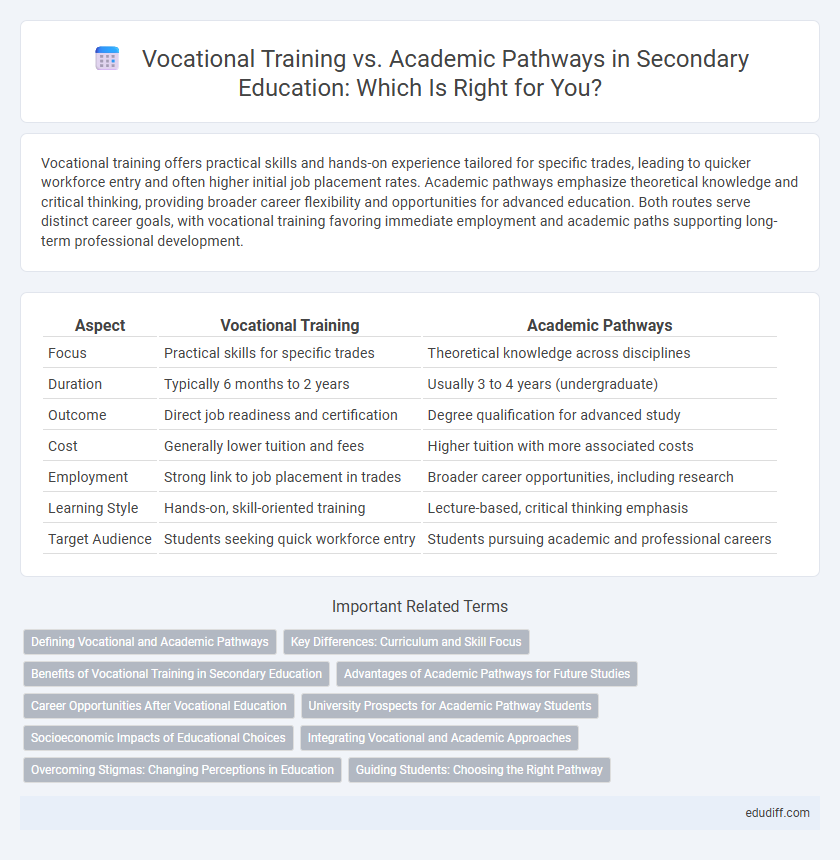Vocational training offers practical skills and hands-on experience tailored for specific trades, leading to quicker workforce entry and often higher initial job placement rates. Academic pathways emphasize theoretical knowledge and critical thinking, providing broader career flexibility and opportunities for advanced education. Both routes serve distinct career goals, with vocational training favoring immediate employment and academic paths supporting long-term professional development.
Table of Comparison
| Aspect | Vocational Training | Academic Pathways |
|---|---|---|
| Focus | Practical skills for specific trades | Theoretical knowledge across disciplines |
| Duration | Typically 6 months to 2 years | Usually 3 to 4 years (undergraduate) |
| Outcome | Direct job readiness and certification | Degree qualification for advanced study |
| Cost | Generally lower tuition and fees | Higher tuition with more associated costs |
| Employment | Strong link to job placement in trades | Broader career opportunities, including research |
| Learning Style | Hands-on, skill-oriented training | Lecture-based, critical thinking emphasis |
| Target Audience | Students seeking quick workforce entry | Students pursuing academic and professional careers |
Defining Vocational and Academic Pathways
Vocational pathways emphasize practical skills and hands-on training tailored to specific careers such as healthcare, engineering, or culinary arts, preparing students for immediate entry into the workforce. Academic pathways focus on theoretical knowledge and critical thinking, typically involving subjects like mathematics, science, and literature, aiming to equip students for higher education and diverse professional fields. Both pathways offer distinct learning environments and outcomes, enabling students to choose based on their career goals and learning preferences.
Key Differences: Curriculum and Skill Focus
Vocational training prioritizes practical, job-specific skills and hands-on experience, designed to prepare students for immediate workforce entry in fields like healthcare, technology, and trades. Academic pathways emphasize theoretical knowledge, critical thinking, and broad subject mastery, often preparing students for further education in universities and diverse professional careers. The curriculum difference centers on applied learning in vocational routes versus conceptual understanding in academic tracks, influencing skill sets and career readiness.
Benefits of Vocational Training in Secondary Education
Vocational training in secondary education equips students with practical skills tailored to specific trades, enhancing employability and career readiness immediately after graduation. This hands-on approach fosters technical proficiency and real-world experience, making students valuable assets in industries such as healthcare, engineering, and information technology. Emphasizing competency-based learning, vocational programs often lead to certifications and apprenticeships that streamline the transition to skilled employment.
Advantages of Academic Pathways for Future Studies
Academic pathways offer comprehensive theoretical foundations critical for advanced studies in fields like medicine, engineering, and law, equipping students with the necessary knowledge for university admission. They provide access to a broad range of academic disciplines, enhancing critical thinking, research skills, and intellectual development essential for postgraduate education. Strong academic credentials from secondary education often increase opportunities for scholarships and acceptance into prestigious institutions for future studies.
Career Opportunities After Vocational Education
Vocational training equips students with practical skills tailored for specific industries such as healthcare, engineering, and information technology, often leading directly to high-demand jobs with competitive salaries. Career opportunities after vocational education include roles like electrician, mechanic, culinary expert, and IT technician, which frequently offer faster employment compared to academic pathways. Many employers value vocational graduates for their hands-on experience and job-ready skills, making this pathway a viable option for immediate entry into the workforce.
University Prospects for Academic Pathway Students
Academic pathway students benefit from greater access to university programs, with 85% pursuing higher education compared to 40% of vocational training peers. Universities often prioritize academic credentials such as A-levels or IB diplomas for admission, enhancing prospects for degrees in fields like medicine, engineering, and law. This pathway also supports specialized research opportunities and scholarships, boosting long-term career development and academic achievement.
Socioeconomic Impacts of Educational Choices
Vocational training offers direct career entry, often reducing unemployment rates in low-income communities and fostering economic stability by equipping students with practical skills. Academic pathways, while promoting higher-level critical thinking and innovation, can lead to increased student debt and delayed workforce participation, impacting socioeconomic mobility. Understanding the balance between these educational choices is crucial for policymaking aimed at reducing inequality and enhancing workforce development.
Integrating Vocational and Academic Approaches
Integrating vocational and academic approaches enhances student engagement by combining practical skills with theoretical knowledge, preparing learners for diverse career opportunities in secondary education. Blended curriculums that incorporate hands-on training alongside academic subjects facilitate deeper understanding and improve employability prospects. Collaborative efforts between schools, industries, and educators support curriculum design that meets evolving labor market demands while maintaining academic rigor.
Overcoming Stigmas: Changing Perceptions in Education
Vocational training is gaining recognition for its practical skills and direct employability, challenging long-held stigmas that favor academic pathways as the only route to success. Initiatives promoting hands-on learning and industry partnerships highlight the value of vocational education in addressing skills gaps and economic demands. Shifting perceptions in education increasingly emphasize diverse pathways, fostering inclusivity and broader definitions of achievement beyond traditional academic degrees.
Guiding Students: Choosing the Right Pathway
Vocational training offers hands-on skills and industry-specific certifications that lead directly to employment, making it an ideal choice for students seeking practical experience and immediate job readiness. Academic pathways emphasize theoretical knowledge and critical thinking, preparing students for higher education and careers requiring advanced degrees. Career counselors and educators should assess students' strengths, interests, and long-term goals to recommend the pathway that aligns best with their aspirations and job market demands.
Vocational Training vs Academic Pathways Infographic

 edudiff.com
edudiff.com